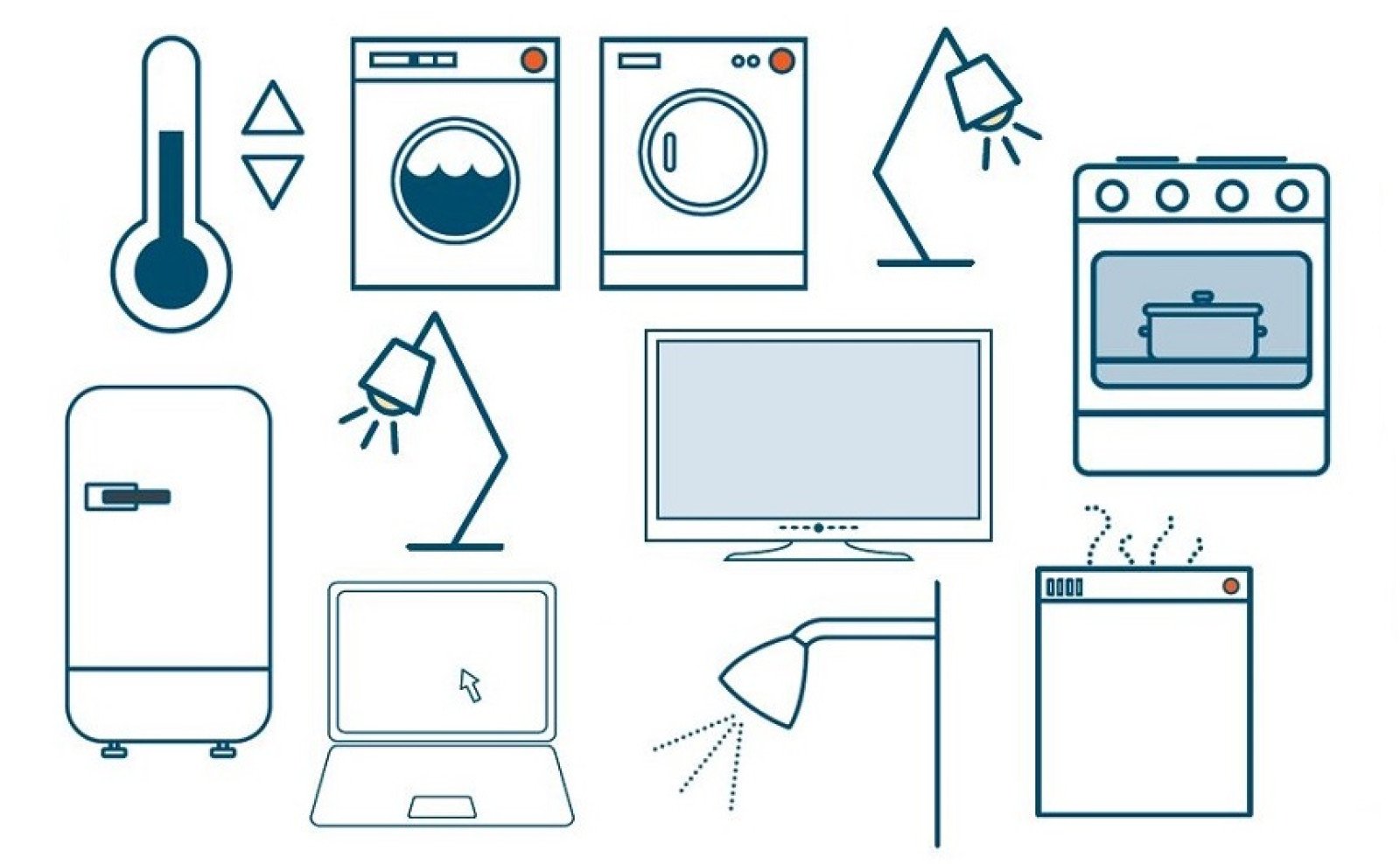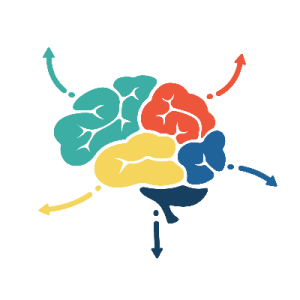Energy consumption challenge
Investigate how we consume electricity in our lives and what devices consume the most energy.

Overview
Machines are devices that transfer force and energy. Learn about appliances that consume the most energy. Using a score sheet, students will compare with their class to see who consumes the least energy in their daily activities.
Instructions
What you'll need
- Laptop and projector
- "Energy consumption" slideshow
- "Energy consumption challenge tally" handout
- Use a laptop and projector to show the "Energy consumption" slides on the board.
- Start a group discussion and ask the class about different types of energy we use every day. Start discussion on solar, wind, and hydro energy as different types of energy is used to do work.
- Ask students what activities they do in their daily lives that require more or less energy. These can include playing video games, watching TV, reading a book, or riding a bike.
- Ask students to raise their hands if they think certain activities use more or less energy. Allow students to offer their thoughts and opinions about different activities and different types of energies.
- Students may think that they use less energy at home, but how do they know for sure? Explain how data is collected, analyzed, and interpreted.
- Let students know they will complete a challenge. They will now be asked to practice a skill that scientists use every day while on the job: collect information (data), analyze, interpret, and present what they find. Explain this is one way to find out if they consume a low or high amount of energy at home.
- The teacher will explain the challenge. Students will receive a "Energy consumption challenge tally" handout.
- Explain to students that there are three categories of activities: Entertainment, transportation, and home. Entertainment includes the choices to read a book instead of watching TV or going to the playground instead of playing video games. Transportation includes the choices to take a walk or take a bike ride. Home includes the choices to turn off the tap when brushing teeth, turning off lights in a room when they are not using it, not leaving the hot water tap running, taking short showers.
- Use a pencil or pen to make a “tally” to record the number of times you choose each activity in each category.
- Repeat this activity every day for 5 or 7 days depending on teaching classroom plans. Energy usage is different depending on the day (weekdays when no one is home during the day vs. weekends when everyone is home).
- Encourage healthy competition. Ask students to remind each other to continue the challenge.
- Optional: You may give a prize to students who complete the challenge. It's best to reward students for completion. If students are rewarded based on the score, they might not be as honest with their tally. It does not have to be a physical prize. For example: students who complete the challenge will receive a “special advantage" in the classroom, and may include being able to choose the classroom activities for 1 day, having no homework for 1 day, extra play time outside, extra free-play time in the classroom, etc.
Math activity
After 5 or 7 days of recording on the score sheets, students will come back as a class and compile their data. Print out the downloadable graph on a large sheet of paper.
Classroom or group data visualization
- Add up the tallies so there is a total “# times used” for each category. For example, if a student counts 9 “tallies” in the Entertainment category on Day 1 on their tally sheet, then they will draw nine dots in the Entertainment section of the downloadable classroom graph. Continue for the other categories.
- Repeat for each student. At the end of data collection, the graph should have different quantities of dots in each category based on students’ tallies.
- Answer the following discussion questions based on grades and levels in the classroom:
- Grades 4-5: Look at the data on the classroom graph, which category (Entertainment, Transportation or Home) had the most dots? Which one had the least? What does this tell us about the choices we make about energy conservation? What patterns of energy conservation can you see?
- For grades 6-7: Compare data with other students in the class. Do you notice any similarities or differences between your data and theirs? Have students pair up and talk with their partner about any patterns that they see in their data. What advice would they give their partner to consume less energy at home? Strategize together and think about what they could do differently.
Depending on classroom levels, teachers may ask students to present their data with different types of graphs or by comparing daily choices and by categories.
- How does the same data look different if graphed as a histogram, scatter plot, or pie chart?
- How could presenting data differently impact how the audience perceives the data and how does this impact their decisions
- What does the data look like if data was collected for 2 weeks or 1 month?
Modify or extend this activity
Ask students about ways they can further conserve energy at home. You may give 1 or 2 examples from the list below to get students thinking.
- Wearing warm layers of clothing instead of turning up the heat.
- Reading a book or playing outside rather than using energy from a laptop.
- Taking showers instead of using bath tubs.
Grades 6 - 7
Ask students to communicate their findings graphically to the class to compare energy use. To extend on data analysis skills, ask students to consider both qualitative and quantitative data.
Qualitative data can include a dialogue between students who choose to use certain appliances and to understand possible differences in cultural practices of energy consumption.
Qualitative data can be presented as stories and narratives to further understand why some families make different choices than other families, even though sometimes, those choices may be less energy-efficient. Qualitative data can help students understand accessibility and privilege when it comes to energy use.
Curriculum Fit
Grade 4 Science
Core competencies: Communication, Thinking, Personal and Social
Big ideas
- Energy can be transformed
- What is energy conservation?
- What is the relationship between energy input, output, and conservation?
Curricular competency
Questioning and predicting
- Demonstrate curiosity about the natural world.
- Observe objects and events in familiar contexts.
- Identify questions about familiar objects and events that can be investigated scientifically.
- Make predictions based on prior knowledge.
Planning and conducting
- Suggest ways to plan and conduct an inquiry to find answers to their questions.
- Make observations about their environment.
- Collect simple data.
Processing and analyzing data and information
- Compare results with predictions, suggesting possible reasons for findings.
Evaluating
- Demonstrate an understanding and appreciation of evidence.
- Identify some simple environmental implications of their and others’ actions.
Communicating
- Represent and communicate ideas and findings in a variety of ways.
- Express and reflect on personal or shared experiences of place.
Grade 5 - 6 Science
Core competencies: Communication, Thinking, Personal and Social
Big ideas
- Machines are devices that transfer force and energy.
- How do machines (natural and human-made) transfer energy?
Curricular competency
Questioning and predicting
- Demonstrate a sustained curiosity about a scientific topic or problem of personal interest.
Planning and conducting
- Choose appropriate data to collect to answer their questions.
- Observe, measure, and record data, using appropriate tools, including digital technologies.
Processing and analyzing data and information
- Construct and use a variety of methods, including tables, graphs, and digital technologies, as appropriate, to represent patterns or relationships in data.
- Identify patterns and connections in data.
- Compare data with predictions and develop explanations for results.
Evaluating
- Demonstrate an understanding and appreciation of evidence.
- Identify some of the social, ethical, and environmental implications of the findings from their own and others’ investigations.
Communicating
- Represent and communicate ideas and findings in a variety of ways.
- Express and reflect on personal or shared experiences of place.
Grade 7 Science
Core competencies: Communication, Thinking, Personal and Social
Big ideas
- The electromagnetic force produces both electricity and magnetism.
- How is electricity generated?
Curricular competency
Questioning and predicting
- Identify a question to answer or a problem to solve through scientific inquiry.
- Make predictions about the findings of their inquiry.
Planning and conducting
- Observe, measure, and record data (qualitative and quantitative), using equipment, including digital technologies, with accuracy and precision.
Processing and analyzing data and information
- Construct and use a range of methods to represent patterns or relationships in data, including tables, graphs, keys, models, and digital technologies as appropriate.
- Seek patterns and connections in data from their own investigations and secondary sources.
Evaluating
- Consider social, ethical, and environmental implications of the findings from their own and others’ investigations.
Communicating
- Represent and communicate ideas and findings in a variety of ways.
- Express and reflect on personal or shared experiences of place.
Teaching Notes
Introduction to energy
- Objective: Help students understand the fundamental concept of energy.
- Notes: Begin by explaining that energy is the ability to do work. Use relatable examples like electricity (e.g., powering lights and gadgets), heat (e.g., warmth from the sun or a stove), and motion (e.g., a moving car).
- Engagement: Ask students to share instances where they have encountered these forms of energy in their daily lives.
- Visual aids: Use diagrams or animations to illustrate energy forms.
Types of energy
- Objective: Introduce different types of energy sources and discuss their characteristics.
- Notes: Differentiate between renewable (e.g., solar, wind) and non-renewable (e.g., fossil fuels) energy sources.
- Discuss the advantages of renewable energy sources (clean, sustainable) and the disadvantages of non-renewable sources (pollution, depletion).
Energy consumption
- Objective: Help students recognize how they use energy daily and quantify their consumption.
- Notes: Energy consumption is the amount of energy that individuals, households, businesses, and nations use to power their daily activities and processes. It's a critical aspect of modern life, as energy powers everything from our homes and transportation to industries and technological devices. Our energy consumption patterns have significant implications for the environment, economy, and overall well-being. Understanding and managing energy consumption is essential for several reasons. Firstly, it directly impacts our utility bills and expenses. By adopting energy-efficient practices and technologies, we can reduce costs and save money. Secondly, excessive energy consumption contributes to environmental issues such as air pollution and climate change. Fossil fuels, a major energy source, release harmful emissions when burned, affecting air quality and the Earth's climate.
Environmental impact
- Objective: Discuss the environmental consequences of excessive energy consumption.
- Notes: Energy consumption contributes to issues like air pollution, climate change, and habitat destruction. Energy consumption has profound environmental consequences. As we harness energy for our daily needs, it often comes from fossil fuels like coal, oil, and natural gas. The combustion of these fuels releases greenhouse gases, such as carbon dioxide (CO2) and methane, into the atmosphere. These gases trap heat, contributing to global warming and climate change, which can result in more extreme weather events, rising sea levels, and disruptions to ecosystems. Moreover, energy production and consumption are major contributors to air and water pollution. Power plants and transportation, powered by non-renewable energy sources, release pollutants like sulfur dioxide (SO2), nitrogen oxides (NOx), and particulate matter, which can harm human health and damage ecosystems. The extraction and transportation of fossil fuels can lead to habitat destruction and environmental degradation. Oil spills, for example, have devastating impacts on marine life and coastal environments.
Energy conservation
- Objective: Teach strategies for conserving energy in daily life.
- Notes: Energy conservation is crucial because it helps protect the environment and saves valuable resources. When we use less energy, we reduce our carbon footprint, which is important for combating climate change.
- Examples:
- Turn off lights: Remember to switch off lights when leaving a room. Natural daylight can often provide sufficient illumination.
- Unplug electronics: Unplug chargers, devices, and appliances when not in use. Even in standby mode, they can still consume energy.
- Use energy-efficient bulbs: Replace traditional incandescent bulbs with energy-efficient LED or CFL bulbs.
- Limit water usage: Saving water conserves energy too. Fix dripping faucets and take shorter showers.
- Close doors and windows: Keep doors and windows closed when using heating or cooling systems to maintain a comfortable temperature.
- Insulate your home: Proper insulation can reduce the need for excessive heating or cooling.
- Use natural ventilation: On cooler days, open windows to let in fresh air instead of relying on air conditioning.
- Reduce screen brightness: Lower the brightness on your devices to save energy and extend battery life.
- Practice responsible screen time: Spend less time on screens, both for energy conservation and your well-being.
Renewable energy
- Objective: Emphasize the importance of transitioning to renewable energy sources.
- Notes: Energy conservation is a vital concept that involves the responsible use and preservation of resources to reduce energy consumption. It's crucial for addressing environmental concerns, reducing costs, and ensuring a sustainable future. Energy conservation encompasses a wide range of practices, from using energy-efficient appliances and lighting to optimizing industrial processes and adopting renewable energy sources. One significant aspect of energy conservation is minimizing wastage. This involves turning off lights when not in use, sealing gaps and insulating buildings to prevent heat loss, and employing energy-efficient technologies to reduce power consumption. Additionally, promoting awareness and education about the importance of energy conservation plays a pivotal role in encouraging individuals and organizations to take meaningful actions. Energy conservation efforts have far-reaching benefits, including a decrease in greenhouse gas emissions, reduced reliance on finite fossil fuels, and lowered utility bills for households and businesses. As societies worldwide strive to combat climate change and promote sustainability, energy conservation remains a fundamental practice in achieving these goals.
- Solar panels and wind turbines are two key technologies that harness renewable energy sources. Solar panels capture energy from sunlight using photovoltaic cells. When sunlight strikes these cells, it creates a flow of electricity, which can be used to power homes and businesses or stored for later use. Solar energy is clean, abundant, and helps reduce reliance on fossil fuels. Wind turbines, on the other hand, generate electricity from the kinetic energy of the wind. As the wind blows, it turns the turbine's blades. This rotational motion drives a generator, producing electrical power. Wind energy is sustainable and emits no greenhouse gases, making it an environmentally-friendly source of electricity. Both solar panels and wind turbines contribute to a more sustainable and cleaner energy future.








